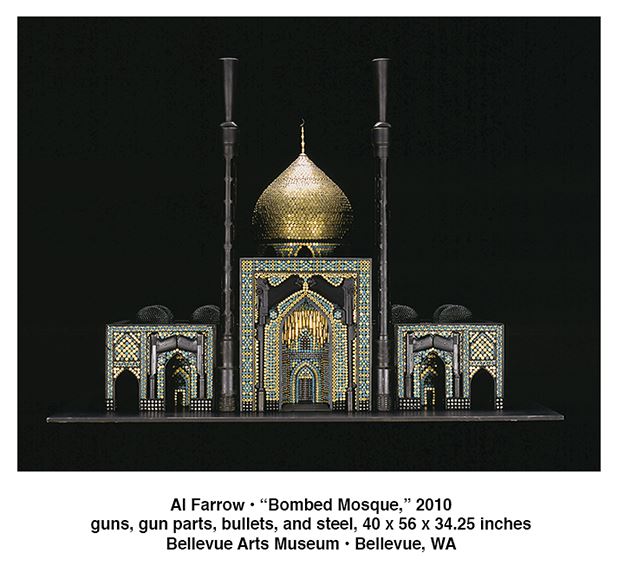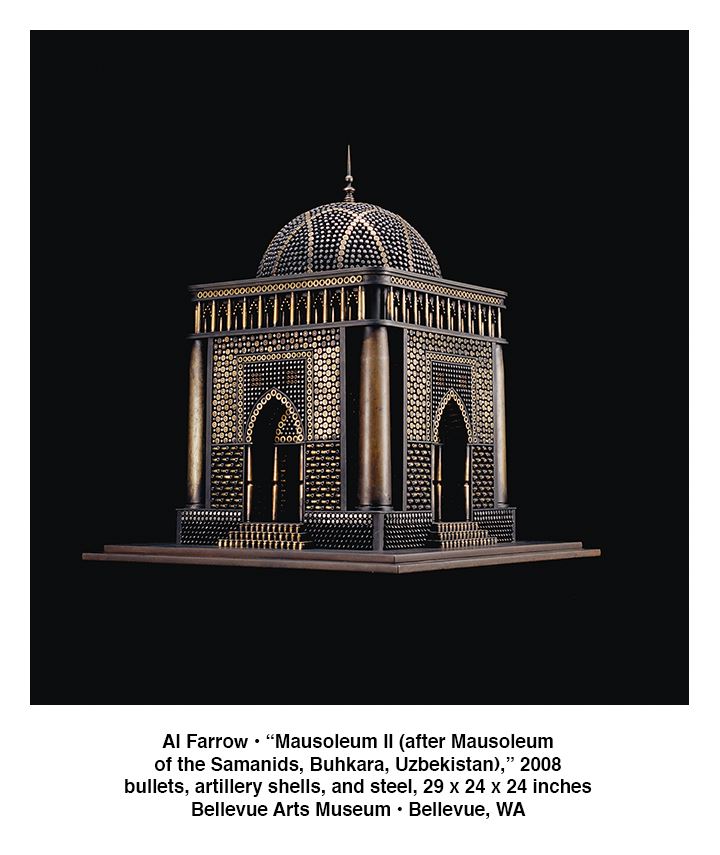Divine Ammunition: The Sculpture of Al Farrow at Bellevue Arts Museum
 Over 50 years ago when Eisenhower gave that speech, violence had reached a tipping point in the United States, and across the globe. World War II brought death and human conflict at a scale the world had never seen before. Nearly 70 million people died as a result of that war. As a result of human violence and combat. At that particular historical moment, making guns had become more important—and more financially lucrative—than ever before.
Over 50 years ago when Eisenhower gave that speech, violence had reached a tipping point in the United States, and across the globe. World War II brought death and human conflict at a scale the world had never seen before. Nearly 70 million people died as a result of that war. As a result of human violence and combat. At that particular historical moment, making guns had become more important—and more financially lucrative—than ever before.
We make guns, but what do guns make? Do they make violence, or do they make stability and structure? And who decides? These are just a few of the questions Al Farrow asks with his show, “Divine Ammunition,” on now at the Bellevue Arts Museum. Farrow meticulously crafts sculptures of religious structures and devotional objects—scale models of mosques and cathedrals, along with menorahs, reliquaries, and icons—all out of guns and ammunition. For him, guns make religion.
A scholar of both religion and war, Farrow has long been interested in the historical connection between violence and religion. In “Divine Ammunition,” he seems most interested in the forms and objects that emerge from the two—objects like guns and reliquaries. Bullets and flying buttresses. Church domes and Uzis. In Farrow’s work, the forms of violence and religion become almost interchangeable. You might not notice that the dome of one of Farrow’s mosques is made entirely out of intricately arranged copper bullets, or that a cathedral buttress is actually a handgun. But look closely, and the munitions reveal themselves.
As Farrow reminds us, it is in objects that we as people come to locate intangible concepts like war and religion. Violence lives in our guns, the tools we use to inflict it. Religion resides in cathedrals and mosques, the structures we build to house it. Religious identity lives in menorahs and reliquaries, the devotional objects we use to invoke it.
With his work, however, Farrow questions all of this. For him, guns are no longer tools of violence, but instead are used as building materials. They become the foundation of the synagogue or mosque. They are creative rather than destructive. Stripped of their firepower and force, Farrow’s spent ammunition and dismembered guns are left only to their forms, becoming bronze circles and cylinders, miniaturized roof tiles and building columns.
 Of course, we know that guns don’t make violence and churches don’t make religion. Humans make these things. It is we who are responsible for our technological advancements, for our industrial developments. It is we humans who figured out how to make double-barreled shotguns and double barrel vaults. And it is we who determine to what use these objects and forms are put.
Of course, we know that guns don’t make violence and churches don’t make religion. Humans make these things. It is we who are responsible for our technological advancements, for our industrial developments. It is we humans who figured out how to make double-barreled shotguns and double barrel vaults. And it is we who determine to what use these objects and forms are put.
Hearing Farrow talk about the process of acquiring his materials—spent ammunition and hundreds of thousands of guns and munitions parts—one is reminded of this very fact. “I used to be very anti-gun and unsympathetic towards the American gun community,” Farrow notes. “I’ve shifted on that, though.” Now, he says, he is more understanding of the various uses to which armament can be put. “I’ve come to realize,” he says, “that gun culture and gun collecting is not so much about violence.” It’s about the object and the appreciation of its historical and cultural significance. Guns are not so far from antiquities and artifacts in that way.
“I am a part of that culture now, gun culture,” Farrow admits. His use—artistic creation—is just one of the many uses to which guns and ammunition can be put. The same object can be an instrument of destruction or of creation. It can kill and it can save. And as Farrow reminds us, creation and destruction will always be intimately intertwined—it’s impossible to have one without the other. The danger, though, is when we cloak that destruction and violence in the shroud of something generative, like religion. Because, as Eisenhower reminded us so many years ago, military strength can bring great power and possibility. But the real power comes in how we choose to use it..WEB.jpg)
Lauren Gallow
Lauren Gallow is an arts writer, critic, and editor. You can read more of her work and learn about her immersive art project “Desert Jewels” at www.desert-jewels.com/writing.
“Divine Ammunition: The Sculpture of Al Farrow” is on view through May 7 at the Bellevue Arts Museum, located at 510 Bellevue Way NE in Bellevue, Washington. Hours are Tuesday through Sunday from 11 A.M. to 6 P.M. For more information, visit www.bellevuearts.org.